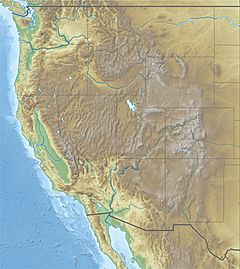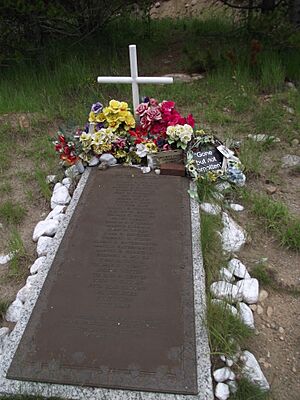Wichita State University football team plane crash facts for kids

A Martin 4-0-4, circa 1981,
in Florida Airlines livery. |
|
| Accident summary | |
|---|---|
| Date | October 2, 1970 |
| Summary | Controlled flight into terrain due to pilot error |
| Place | Clear Creek County, Colorado 8 miles (13 km) west of Silver Plume, near the Loveland Ski Area 39°41′36″N 105°52′57″W / 39.69333°N 105.88250°W |
| Passengers | 37 |
| Crew | 3 |
| Injuries (non-fatal) | 9 |
| Fatalities | 31 |
| Survivors | 9 |
| Aircraft type | Martin 4-0-4 |
| Airline/user | Golden Eagle Aviation |
| Registration | N464M |
| Flew from | Wichita Mid-Continent Airport |
| Stopover | Stapleton International Airport |
| Flying to | Logan-Cache Airport |
On Friday, October 2, 1970, a plane carrying the Wichita State Shockers football team crashed. This happened in Colorado in clear, calm weather. The plane, a Martin 4-0-4 airliner, hit a mountain. It was about eight miles (13 km) west of Silver Plume.
The plane was operated by Golden Eagle Aviation. It had 37 passengers and a crew of three people. Sadly, 29 people died right away. Two more died later from their injuries. This brought the total number of deaths to 31.
This was one of two planes taking the football team to Logan, Utah. They were going to play a game against Utah State. The second plane took a normal route and arrived safely. Investigators later said that mistakes by the pilots caused the crash. These mistakes included bad decisions during the flight and not planning enough before takeoff.
Contents
What Led to the Crash?
About three months before the crash, Wichita State made a deal. They hired Golden Eagle Aviation to fly their team to away games. The original plan was to use a large Douglas DC-6B plane. This plane was big and powerful enough for the whole team.
However, the DC-6 was damaged in a windstorm. It could not be used for the flights. Instead, Golden Eagle Aviation used two Martin 4-0-4 planes. These planes had not flown since 1967. They were checked and made ready for flight again. On October 2, 1970, these two planes flew to Wichita.
The Start of the Trip
When the two planes arrived in Wichita, bags were loaded. The passengers, including the football team, got on board. The planes took off and flew west. Their first stop was in Denver at Stapleton Airport for fuel. From there, they would fly to Logan Airport in Utah.
The two planes were called "Gold" and "Black." These were the school colors. The "Gold" plane carried the main players, the head coach, and the athletic director. It also had their wives, other staff, and family members. The "Black" plane carried the reserve players and assistant coaches.
Ronald G. Skipper, the president of Golden Eagle Aviation, was flying the "Gold" plane. He was sitting in the left seat. He told passengers they would take a "scenic route" after refueling. This route would fly near Loveland Ski Area and Mount Sniktau. The captain of the "Gold" plane was Danny E. Crocker. The crew of the "Black" plane stuck to the original flight plan. They took a route that went north from Denver, then west. This route was less scenic but safer for flying over the Rocky Mountains.
How the Accident Happened
In Denver, First Officer Skipper bought special maps for the scenic route. The National Transportation Safety Board (NTSB) investigated the crash. The NTSB report said Skipper wanted to use the maps to show landmarks to passengers. But the crew did not take enough time to study the maps properly. They did not plan how to avoid high mountains before taking off.
After takeoff, the two planes flew in different directions from Denver.
Just before the crash, many people saw a plane flying very low. It was flying towards the Continental Divide. Some witnesses were on higher mountains. They said the plane was flying below them. Rick Stephens, a player who survived, said he saw old mines and vehicles above them. He realized they were flying very low. He went to the cockpit and saw only green in front of the plane. This meant they were flying straight into the mountains.
The "Gold" plane was carrying too much weight. It flew up Clear Creek Valley. It got stuck in a box canyon. This is a canyon with high ridges on three sides. The plane could not climb high enough to get over the mountains. It also could not turn around safely. At 1:14 p.m., the plane hit trees on Mount Trelease. It crashed about 1,600 feet below the mountain's top.
The NTSB report said many people likely survived the first impact. This was based on what survivors and rescuers said. The plane's fuel did not explode right away. This allowed some survivors to get out. But the passenger area later caught fire. People still trapped inside could not escape.
Out of 40 people on board, 29 died at the crash site. This included 27 passengers, the captain, and a flight attendant. Two of the 11 people who survived at first later died from their injuries. This made the total number of deaths 31. Fourteen of those who died were Wichita State football players. Construction workers and drivers were the first to arrive at the crash site. The first officer, Ronald Skipper, survived.
Why the Crash Happened
The National Transportation Safety Board (NTSB) investigated the crash. Their report said that the weather was not a cause. The NTSB said the main reason for the crash was the pilot's bad decisions. These decisions were made during the flight and when planning the trip.
The report stated the plane was flown over a mountain valley. It was at an altitude where it could not climb over the mountains ahead. It also could not turn around safely. Other important reasons were:
- The plane was carrying too much weight.
- There was almost no flight planning for the route they chose.
- The crew did not understand what the plane could and could not do.
- There was not enough management to check and control the crew's actions.
What Happened Next
After the crash, the game against Utah State was canceled. Utah State's football team held a memorial service. They placed a wreath on the 50-yard line of their stadium. The Governor of Kansas, Robert Docking, sent a plane. It flew Wichita State officials and families of survivors to Denver.
Classes at Wichita State were canceled for Monday, October 5. A memorial service was held that evening at Cessna Stadium. The remaining members of the Wichita State team decided to keep playing the 1970 season. The NCAA allowed new freshman players to join the team. This part of the season was called the "Second Season."
Wichita State and Utah State had played each other often before. But they never played football again after the crash. Wichita State stopped having a varsity football team after the 1986 season.
This crash was the first of two college football team plane crashes in 1970. Six weeks later, another plane crashed. It was carrying the Marshall University team. That crash happened in Huntington, West Virginia.
Memorials
Wichita State University built a memorial called Memorial '70. It honors those who died in the crash. Every year on October 2 at 9 a.m., a wreath is placed there.
There is also a memorial plaque near the crash site in Colorado. It lists the names of the victims. You can find it next to westbound Interstate 70. It is at Dry Gulch at milepost 217. This is about two miles (3 km) east of the Eisenhower Tunnel. A path to the crash site starts near the memorial.
After the crash, entertainers Bill Cosby and Monty Hall helped. They hosted a fundraiser for the Wichita State athletic department.
See also
- List of accidents involving sports teams
- Timeline of college football in Kansas



